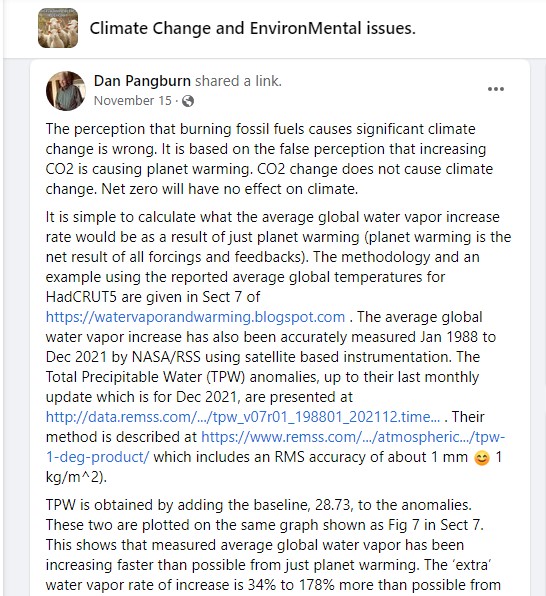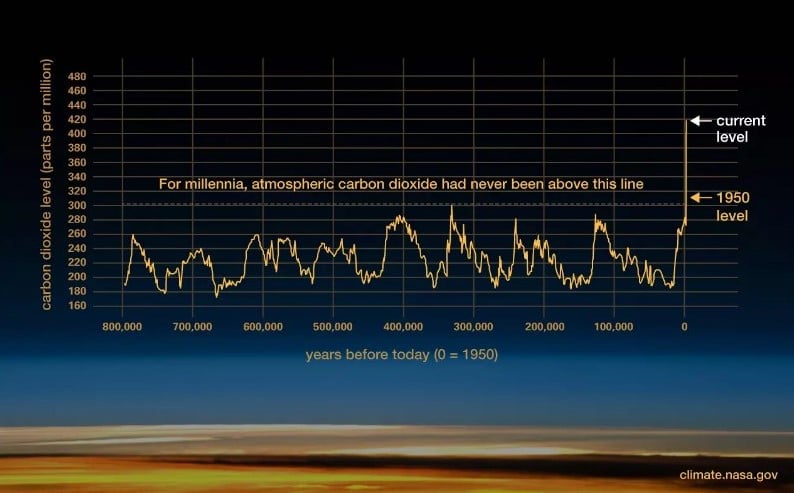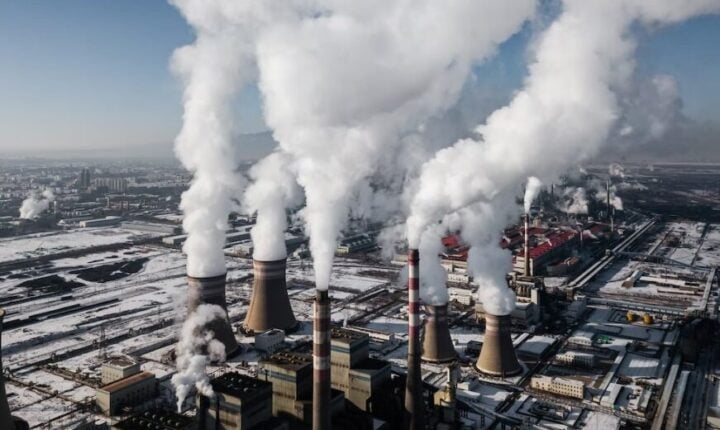A Facebook post with multiple claims says burning fossil fuels have no significant effect on climate change; that water vapour, not carbon dioxide (CO2), is solely responsible for global warming.
“The perception that burning fossil fuels causes significant climate change is wrong,” partly reads the claim shared in a Facebook group named, Climate Change and EnvironMental issues.
The post adds that the “perception that increasing CO2 is causing planet warming” is false, instead increase in water vapour is solely responsible for the rise in global temperatures.

Advertisement
The Facebook message which downplays human contribution to global warming was posted on November 15, in a group that claims to aid open climate discussions using scientific evidence.
TheCable checked the accuracy of the climate claims and here is what we found.
CLAIM 1: Co2 is not the main driver of climate change
Advertisement
A 2021 report by the United Nations’ Intergovernmental Panel on Climate Change (IPCC), reaffirmed the long-established fact that human-caused climate change, poses a huge danger to the world.
The report, tagged “code red for humanity”, alludes to the fact that carbon dioxide is the main driver of climate change, even as other greenhouse gases and air pollutants play significant roles.
Analysing the IPCC report, Helen Mountford, president of ClimateWorks Foundation in the United States, told USAToday: “The report paints a very sobering picture of the unforgiving, unimaginable world we have in store if our addiction to burning fossil fuels and destroying forests continues. One of the most striking takeaways is that we may reach 1.5°C of warming a decade earlier than the IPCC had previously found.”
Scientific data provided by the National Aeronautics and Space Administration (NASA), a US agency responsible for civil space and aeronautics research, show that atmospheric CO2 has increased since the industrial revolution.
Advertisement

Science has established that the burning of fossil and deforestation are the two main activities responsible for increasing CO2 concentration in the atmosphere, hence driving global warming.
Global warming is responsible for the melting of ice caps, drought, rise in sea level and coastal flooding which displaces human population.
The atmosphere contains greenhouse gases which include water vapour, carbon dioxide, methane and nitrous oxides. These gases all aid heat retention, a phenomenon referred to as the greenhouse effect.
An increase in industrial activities by humans has led to increased levels of greenhouse gases, which implies that more heat is being trapped, resulting in the phenomenon known as global warming.
Advertisement
It is important to note that forests and vegetations provide the atmospheric oxygen needed for the survival of man and animals. Human activity is producing more carbon, and at the same time, destroying carbon sinks – like trees – through deforestation.
Through the felling of trees without replacement, carbon sinks which should absorb CO2 are destroyed in large numbers. As a result of this, carbon dioxide is accumulated in the atmosphere in unprecedented amounts, for thousands of years.
Advertisement
Gloria Okafor, a postdoctoral research scientist, at the Nigerian Maritime University in Delta state, Nigeria, told TheCable that “CO2 is evidently a major contributor to climate change and global temperature increase”.
According to the university lecturer, more than enough proof has been established to show that the concentration of human-generated greenhouse gas significantly impacts global warming.
Advertisement
VERDICT: The claim that fossil fuels do not impact climate change is false.
CLAIM 2: An increase in water vapour is solely responsible for the rise in global temperatures
Advertisement
Water vapour is formed when water from the ocean or land evaporates and rises up to the atmosphere. Water vapour is the most abundant greenhouse gas in the atmosphere, accounting for about 60% of the earth’s greenhouse warming effect.
How water vapour and CO2 affect climate change
The amount of carbon dioxide in the atmosphere is proportionally smaller to that of other gases, such as water vapour. However, the abundance of vapour does not in any way imply that CO2 has no impact on the atmosphere and global warming, as the Facebook post suggests.
In a scientific report where climate change indicators were listed, the United States Environmental Protection Agency (EPA), explained that the surface warming caused by human production of other greenhouse gases, leads to an increase in atmospheric water vapour. This occurs because warmer temperatures make it easier for water to evaporate and stay in the air in vapour form. Hence, creating a positive “feedback loop” leading to increased warming.
Through this process alone, water vapour amplifies the warming experienced on earth from carbon dioxide, even more, because water vapour is indeed a very effective greenhouse gas.
Humans have significant control over the amount of CO2 in the atmosphere, but not over water vapour, which is majorly influenced by the degree of earth warming. Carbon dioxide doesn’t condense like water vapour, and it takes considerable time to be removed from the atmosphere. Therefore, any increase in CO2 is a definite increase in temperature.
CO2 and water vapour both contribute to the “greenhouse effect” that warms the earth and makes it habitable for humans. However, they play very different roles.
Increased CO2 levels significantly affect climate change. On the other hand, an increase in the quantity of water vapour in the atmosphere is caused by warming, which is a result of climate change.
VERDICT: The social media claim that the increase in water vapour is solely responsible for the rise in global temperatures is false.
Water vapour has been proven to contribute to climate change, however, it’s not the water vapour that is causing the change, it is actually responding to the change and amplifying it.
This fact check was produced by TheCable with support from Code for Africa’s PesaCheck, International Fact-Checking Network, and African Fact Checking Alliance network.
Add a comment







